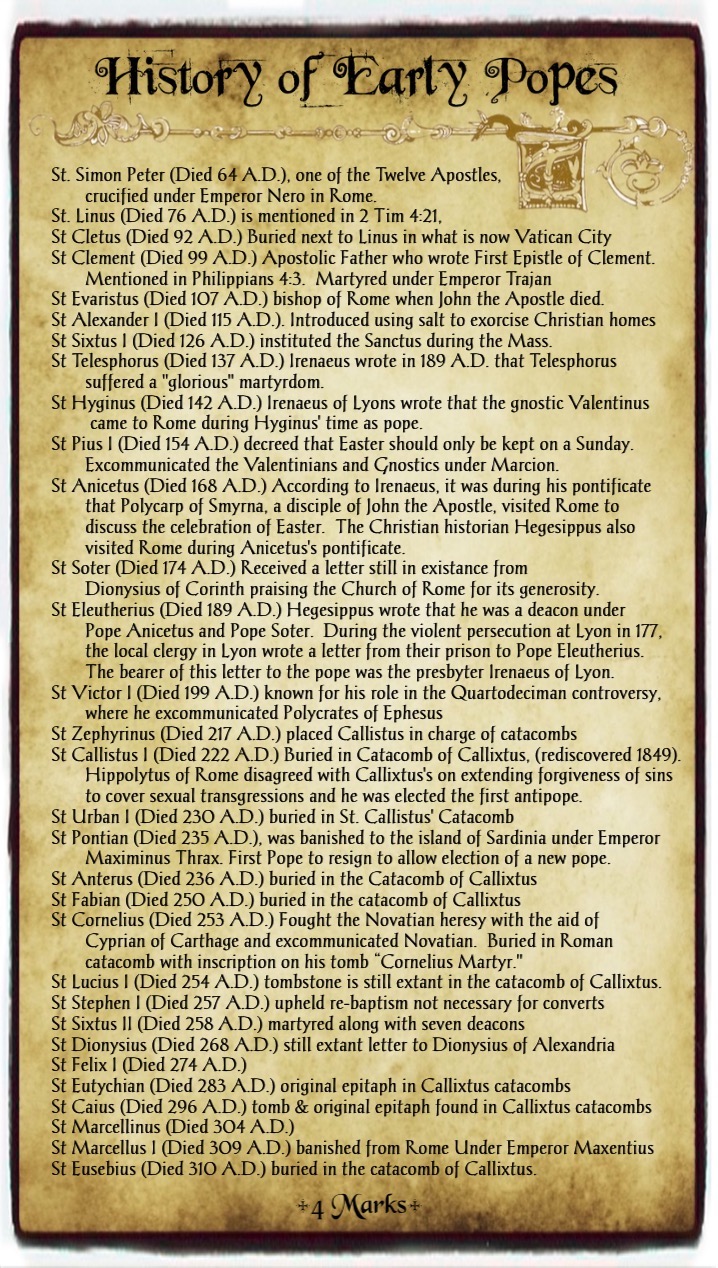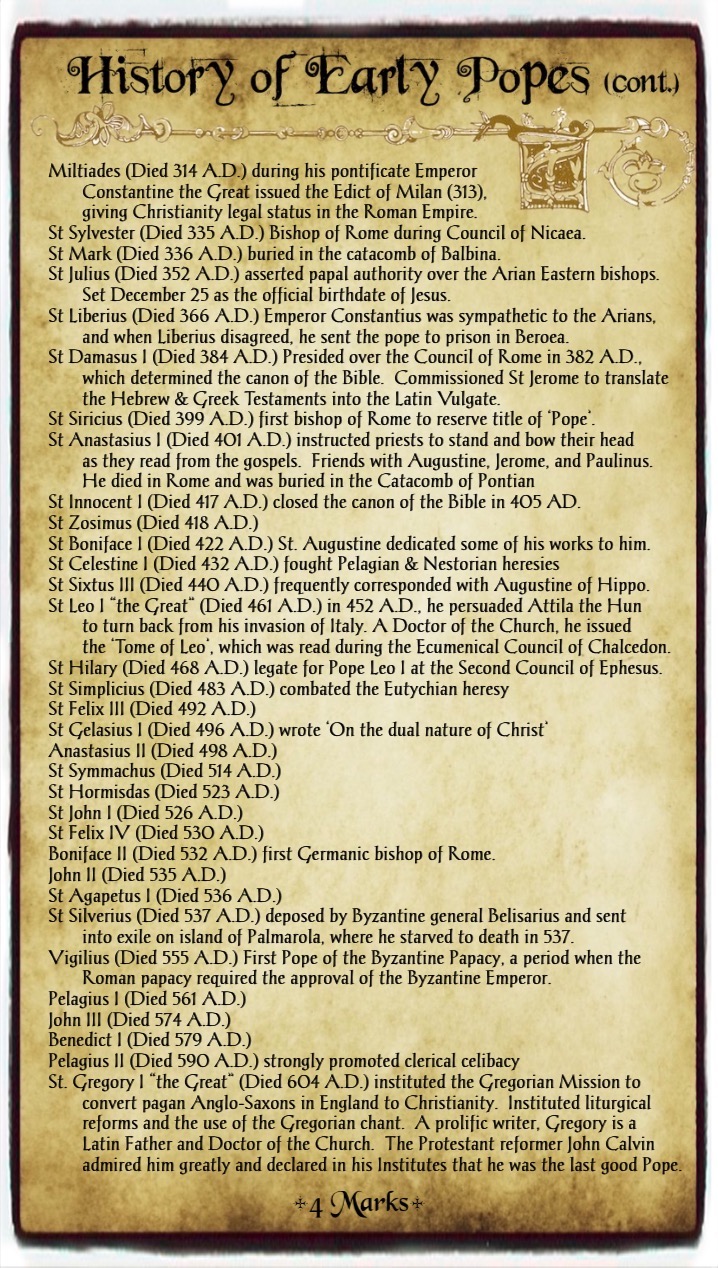
Brief History of the
Early Popes:
The First 3 Centuries:
- St. Simon Peter (Died 64 A.D.), one of the Twelve Apostles, crucified under Emperor Nero in Rome.
- St. Linus (Died 76 A.D.) is mentioned in 2 Tim 4:21
- St Cletus (Died 92 A.D.) Buried next to Linus in what is now Vatican City
- St Clement (Died 99 A.D.) Apostolic Father who wrote First Epistle of Clement. Mentioned in Philippians 4:3. Martyred under Emperor Trajan
- St Evaristus (Died 107 A.D.) bishop of Rome when John the Apostle died.
- St Alexander I (Died 115 A.D.). Introduced using salt to exorcise Christian homes
- St Sixtus I (Died 126 A.D.) instituted the Sanctus during the Mass.
- St Telesphorus (Died 137 A.D.) Irenaeus wrote in 189 A.D. that Telesphorus
suffered a “glorious” martyrdom. - St Hyginus (Died 142 A.D.) Irenaeus of Lyons wrote that the gnostic Valentinus came to Rome during Hyginus’ time as pope.
- St Pius I (Died 154 A.D.) decreed that Easter should only be kept on a Sunday. Excommunicated the Valentinians and Gnostics under Marcion.
- St Anicetus (Died 168 A.D.) According to Irenaeus, it was during his pontificate that Polycarp of Smyrna, a disciple of John the Apostle, visited Rome to discuss the celebration of Easter. The Christian historian Hegesippus also visited Rome during Anicetus’s pontificate.
- St Soter (Died 174 A.D.) Received a letter still in existance from Dionysius of Corinth praising the Church of Rome for its generosity.
- St Eleutherius (Died 189 A.D.) Hegesippus wrote that he was a deacon under Pope Anicetus and Pope Soter. During the violent persecution at Lyon in 177, the local clergy in Lyon wrote a letter from their prison to Pope Eleutherius. The bearer of this letter to the pope was the presbyter Irenaeus of Lyon.
- St Victor I (Died 199 A.D.) known for his role in the Quartodeciman controversy, where he excommunicated Polycrates of Ephesus.
- St Zephyrinus (Died 217 A.D.) placed Callistus in charge of catacombs.
- St Callistus I (Died 222 A.D.) Buried in Catacomb of Callixtus (rediscovered 1849). Hippolytus of Rome disagreed with Callixtus’s on extending forgiveness of sins
to cover sexual transgressions and he was elected the first antipope. - St Urban I (Died 230 A.D.) buried in St. Callistus’ Catacomb
- St Pontian (Died 235 A.D.), was banished to the island of Sardinia under Emperor Maximinus Thrax. First Pope to resign to allow election of a new pope.
- St Anterus (Died 236 A.D.) buried in the Catacomb of Callixtus
- St Fabian (Died 250 A.D.) buried in the catacomb of Callixtus
- St Cornelius (Died 253 A.D.) Fought the Novatian heresy with the aid of Cyprian of Carthage and excommunicated Novatian. Buried in Roman catacomb with inscription on his tomb “Cornelius Martyr.”
- St Lucius I (Died 254 A.D.) tombstone is still extant in the catacomb of Callixtus.
- St Stephen I (Died 257 A.D.) upheld re-baptism not necessary for converts
- St Sixtus II (Died 258 A.D.) martyred along with seven deacons
- St Dionysius (Died 268 A.D.) still extant letter to Dionysius of Alexandria
- St Felix I (Died 274 A.D.)
- St Eutychian (Died 283 A.D.) original epitaph in Callixtus catacombs
- St Caius (Died 296 A.D.) tomb & original epitaph found in Callixtus catacombs
- St Marcellinus (Died 304 A.D.)
- St Marcellus I (Died 309 A.D.) banished from Rome Under Emperor Maxentius
- St Eusebius (Died 310 A.D.) buried in the catacomb of Callixtus.
The Second 3 Centuries:
- Miltiades (Died 314 A.D.) during his pontificate Emperor Constantine the Great issued the Edict of Milan (313), giving Christianity legal status in the Roman Empire.
- St Sylvester (Died 335 A.D.) Bishop of Rome during Council of Nicaea.
- St Mark (Died 336 A.D.) buried in the catacomb of Balbina.
- St Julius (Died 352 A.D.) asserted papal authority over the Arian Eastern bishops. Set December 25 as the official birthdate of Jesus.
- St Liberius (Died 366 A.D.) Emperor Constantius was sympathetic to the Arians, and when Liberius disagreed, he sent the pope to prison in Beroea.
- St Damasus I (Died 384 A.D.) Presided over the Council of Rome in 382 A.D., which determined the canon of the Bible. Commissioned St Jerome to translate the Hebrew & Greek Testaments into the Latin Vulgate.
- St Siricius (Died 399 A.D.) first bishop of Rome to reserve title of ‘Pope’.
- St Anastasius I (Died 401 A.D.) instructed priests to stand and bow their head as they read from the gospels. Friends with Augustine, Jerome, and Paulinus. He died in Rome and was buried in the Catacomb of Pontian
- St Innocent I (Died 417 A.D.) closed the canon of the Bible in 405 AD.
- St Zosimus (Died 418 A.D.)
- St Boniface I (Died 422 A.D.) St. Augustine dedicated some of his works to him.
- St Celestine I (Died 432 A.D.) fought Pelagian & Nestorian heresies
- St Sixtus III (Died 440 A.D.) frequently corresponded with Augustine of Hippo.
- St Leo I “the Great” (Died 461 A.D.) in 452 A.D., he persuaded Attila the Hun to turn back from his invasion of Italy. A Doctor of the Church, he issued the ‘Tome of Leo’, which was read during the Ecumenical Council of Chalcedon.
- St Hilary (Died 468 A.D.) legate for Pope Leo I at the Second Council of Ephesus.
- St Simplicius (Died 483 A.D.) combated the Eutychian heresy
- St Felix III (Died 492 A.D.)
- St Gelasius I (Died 496 A.D.) wrote ‘On the dual nature of Christ’
- Anastasius II (Died 498 A.D.)
- St Symmachus (Died 514 A.D.)
- St Hormisdas (Died 523 A.D.)
- St John I (Died 526 A.D.)
- St Felix IV (Died 530 A.D.)
- Boniface II (Died 532 A.D.) first Germanic bishop of Rome.
- John II (Died 535 A.D.)
- St Agapetus I (Died 536 A.D.)
- St Silverius (Died 537 A.D.) deposed by Byzantine general Belisarius and sent into exile on island of Palmarola, where he starved to death in 537.
- Vigilius (Died 555 A.D.) First Pope of The Byzantine Papacy, a period when the Roman papacy required the approval of the Byzantine Emperor.
- Pelagius I (Died 561 A.D.)
- John III (Died 574 A.D.)
- Benedict I (Died 579 A.D.)
- Pelagius II (Died 590 A.D.) strongly promoted clerical celibacy
- St. Gregory I “the Great” (Died 604 A.D.) instituted the Gregorian Mission to
convert pagan Anglo-Saxons in England to Christianity. Instituted liturgical
reforms and the use of the Gregorian chant. A prolific writer, Gregory is a Latin Father and Doctor of the Church. The Protestant reformer John Calvin admired him greatly and declared in his Institutes that he was the last good Pope.

